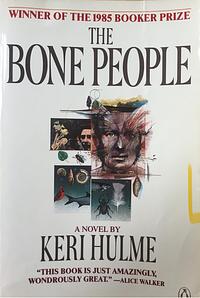Take a photo of a barcode or cover
challenging
dark
emotional
mysterious
reflective
sad
slow-paced
Plot or Character Driven:
Character
Strong character development:
Complicated
Loveable characters:
Complicated
Diverse cast of characters:
Yes
Flaws of characters a main focus:
Yes
Graphic: Child abuse, Medical content
Moderate: Death, Grief, Abandonment, Alcohol, Injury/Injury detail
Minor: Body shaming
Loved it til the ending, not sure how i feel about the end
challenging
dark
emotional
medium-paced
Plot or Character Driven:
Plot
Strong character development:
Yes
Loveable characters:
Complicated
Diverse cast of characters:
Yes
Flaws of characters a main focus:
Yes
This book focuses mainly on three people: Joe, Kerewin and Simon. They form a very dysfunctional family by the end of the book, they each have their difficult baggage, their secrets, their struggles. It is a very nuance book about the relationships of people, what is good and what is bead, the difficulties of love. It was complex but the writing gave a full picture without getting in the way.
Par où commencer…
J’attendais beaucoup de The Bone People. On m’avait vendu un roman magistral sur la Nouvelle-Zélande, la culture Maori et la colonisation, avec de la représentation aroace… Et c’est vrai. À part la partie « roman magistral », il y a tout ça. Et c’est d’ailleurs pour cette raison que je mets deux étoiles. Ça et les descriptions incroyables de la NZ, qui me donnent encore plus envie d’endosser un sac et de prendre le premier avion.
Mais.
Mais le roman, qui veut parler des outcasts et des gens traumatisés, tombe dans un des pires travers qui soit : la romanticisation des violences domestiques.
Ces passages m’ont révoltée, m’ont donné la nausée. Je ne voyais pas où l’autrice où voulait en venir, mais je me disais qu’il y avait peut-être un but, une dénonciation, un message fort à retenir.
J’attendais vraiment que Keri Hulme prenne ses responsabilités, et qu’elle aille au bout de la démarche qu’elle semblait avoir entrepris.
J’attendais qu’on dénonce les violences sur les enfants, et qu’on ne fasse pas passer le type qui manque de tuer son fils adoptif pour « un bon gars » qui « aime son gamin ». Parce que non. Aimer ce n’est pas frapper. Aimer ce n’est pas faire boire et fumer un enfant de six ans. Aimer ce n’est pas non plus insister lourdement auprès de son « amie » aroace pour qu’elle se laisse convaincre par du cul, ou un mariage.
J’attendais que Kerewin, que beaucoup décrivent comme une Mary-Sue, mais que j’aimais tout de même beaucoup, ne se fâche pas pour une guitare abîmée. La portée sentimentale était importante, mais l’était-elle plus que l’intégrité physique, mentale et même que la vie d’un enfant ? Je ne crois pas. C’est probablement le personnage qui m’a le plus déçue d’ailleurs. Elle a complètement rompu la confiance que j’avais mise en elle, passant outre ses manquements, attendant qu’elle se réveille de son marasme pour protéger Simon pour de bon. Joe, j’ai compris tout de suite que c’était un connard. Je n’ai jamais pu comprendre l’amitié de Kerewin à son égard, mais eh, j’ai été à sa place, je sais qu’on peut faire confiance à des mecs sans voir à quel point ils sont toxiques. Mais que Kerewin nous abandonne Simon et moi, j’ai eu du mal à l’avaler.
À ce moment précis, l’autrice aurait quand même pu faire tourner les choses autrement. L’événement horrible aurait pu permettre de dénoncer quelque chose. Mais au lieu de ça, on tombe dans l’auto-apitoiement des deux adultes qui sont sauvés grâce à une nouvelle foi et l’intervention de dieux maoris ?? Et on a un enfant de sept ans profondément traumatisé qu’un pédiatre va faire fumer et aider à retourner dans son foyer dysfonctionnel en lui donnant des tips pour se mettre encore plus en danger.
Et c’est censé être une fin cool ? Très peu pour moi.
J’attendais beaucoup de The Bone People. On m’avait vendu un roman magistral sur la Nouvelle-Zélande, la culture Maori et la colonisation, avec de la représentation aroace… Et c’est vrai. À part la partie « roman magistral », il y a tout ça. Et c’est d’ailleurs pour cette raison que je mets deux étoiles. Ça et les descriptions incroyables de la NZ, qui me donnent encore plus envie d’endosser un sac et de prendre le premier avion.
Mais.
Mais le roman, qui veut parler des outcasts et des gens traumatisés, tombe dans un des pires travers qui soit : la romanticisation des violences domestiques.
Ces passages m’ont révoltée, m’ont donné la nausée. Je ne voyais pas où l’autrice où voulait en venir, mais je me disais qu’il y avait peut-être un but, une dénonciation, un message fort à retenir.
J’attendais vraiment que Keri Hulme prenne ses responsabilités, et qu’elle aille au bout de la démarche qu’elle semblait avoir entrepris.
J’attendais qu’on dénonce les violences sur les enfants, et qu’on ne fasse pas passer le type qui manque de tuer son fils adoptif pour « un bon gars » qui « aime son gamin ». Parce que non. Aimer ce n’est pas frapper. Aimer ce n’est pas faire boire et fumer un enfant de six ans. Aimer ce n’est pas non plus insister lourdement auprès de son « amie » aroace pour qu’elle se laisse convaincre par du cul, ou un mariage.
J’attendais que Kerewin, que beaucoup décrivent comme une Mary-Sue, mais que j’aimais tout de même beaucoup, ne se fâche pas pour une guitare abîmée. La portée sentimentale était importante, mais l’était-elle plus que l’intégrité physique, mentale et même que la vie d’un enfant ? Je ne crois pas. C’est probablement le personnage qui m’a le plus déçue d’ailleurs. Elle a complètement rompu la confiance que j’avais mise en elle, passant outre ses manquements, attendant qu’elle se réveille de son marasme pour protéger Simon pour de bon. Joe, j’ai compris tout de suite que c’était un connard. Je n’ai jamais pu comprendre l’amitié de Kerewin à son égard, mais eh, j’ai été à sa place, je sais qu’on peut faire confiance à des mecs sans voir à quel point ils sont toxiques. Mais que Kerewin nous abandonne Simon et moi, j’ai eu du mal à l’avaler.
À ce moment précis, l’autrice aurait quand même pu faire tourner les choses autrement. L’événement horrible aurait pu permettre de dénoncer quelque chose. Mais au lieu de ça, on tombe dans l’auto-apitoiement des deux adultes qui sont sauvés grâce à une nouvelle foi et l’intervention de dieux maoris ?? Et on a un enfant de sept ans profondément traumatisé qu’un pédiatre va faire fumer et aider à retourner dans son foyer dysfonctionnel en lui donnant des tips pour se mettre encore plus en danger.
Et c’est censé être une fin cool ? Très peu pour moi.
dark
emotional
mysterious
sad
tense
Plot or Character Driven:
Character
Strong character development:
Yes
Loveable characters:
No
Diverse cast of characters:
Yes
Flaws of characters a main focus:
Yes
dark
emotional
hopeful
reflective
sad
tense
medium-paced
Plot or Character Driven:
Character
Strong character development:
Yes
The confusing language and structure at the beginning of the book could easily put someone off reading it and I wouldn't blame them. I don't need things spelled out for me, but at the same time I've never been a fan of deliberate obfuscations that too-clever writers put out for their long-suffering readers (I'm looking at you as well, Eco, with that untranslatable Hebrew epigraph to [book:Foucault's Pendulum|17841]). In some regards I see what they're doing, preparing you for a read that uses language unconventionally, but I think there's more talent in clarity. I never fell in love with the writing style anyways, but keep in mind that my definition of beautiful use of language is the Neoromantic, the gilded and jewelled styles of late 19th-century Decadence, and that I have less of an interest in the post-modern.
She created scenes and settings strongly, there are a lot of images that stand out in my mind from this book. I liked that she refused to set out rigid delineations of good or bad, right or wrong, Pākehā or Māori. Obviously this is a tough book that deals with really tough themes, not glorying in the pain and hurt it portrays but not letting us look away from it either. Is the abuse is monstrous? Yes. Is the abuse is human? Yes. Oh, yes.
She created scenes and settings strongly, there are a lot of images that stand out in my mind from this book. I liked that she refused to set out rigid delineations of good or bad, right or wrong, Pākehā or Māori. Obviously this is a tough book that deals with really tough themes, not glorying in the pain and hurt it portrays but not letting us look away from it either. Is the abuse is monstrous? Yes. Is the abuse is human? Yes. Oh, yes.
Someone told me that every New Zealander has read this book, so I bought it in anticipation of my trip to Wellington. Sure enough, every time I pulled it out at a cafe or on a bench, someone would come up to discuss it with me. Worthwhile for that reason alone!
Kiwis aside, the language created by a visual artist attempting verbal storytelling is amazing, inspiring, soothing.
Kiwis aside, the language created by a visual artist attempting verbal storytelling is amazing, inspiring, soothing.
challenging
dark
emotional
mysterious
reflective
sad
tense
slow-paced
Plot or Character Driven:
A mix
Strong character development:
Yes
Loveable characters:
Yes
Diverse cast of characters:
Yes
Flaws of characters a main focus:
Yes







